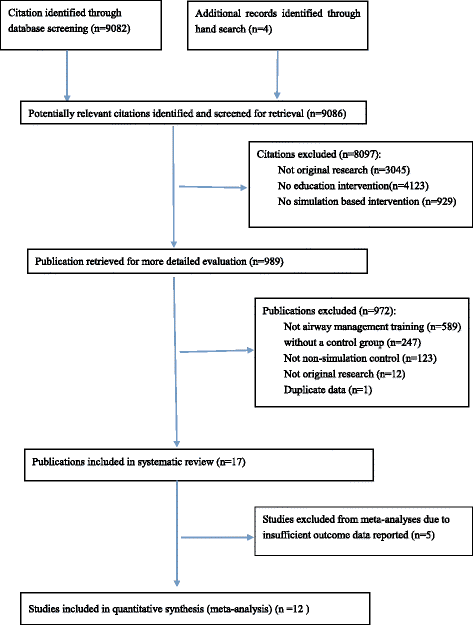Airway management education: simulation based training versus non-simulation based training-A systematic review and meta-analyses
- PMID: 28143389
- PMCID: PMC5286685
- DOI: 10.1186/s12871-017-0313-7
Airway management education: simulation based training versus non-simulation based training-A systematic review and meta-analyses
Abstract
Background: Simulation-based training (SBT) has become a standard for medical education. However, the efficacy of simulation based training in airway management education remains unclear.
Methods: The aim of this study was to evaluate all published evidence comparing the effectiveness of SBT for airway management versus non-simulation based training (NSBT) on learner and patient outcomes. Systematic review with meta-analyses were used. Data were derived from PubMed, EMBASE, CINAHL, Scopus, the Cochrane Controlled Trials Register and Cochrane Database of Systematic Reviews from inception to May 2016. Published comparative trials that evaluated the effect of SBT on airway management training in compared with NSBT were considered. The effect sizes with 95% confidence intervals (CI) were calculated for outcomes measures.
Results: Seventeen eligible studies were included. SBT was associated with improved behavior performance [standardized mean difference (SMD):0.30, 95% CI: 0.06 to 0.54] in comparison with NSBT. However, the benefits of SBT were not seen in time-skill (SMD:-0.13, 95% CI: -0.82 to 0.52), written examination score (SMD: 0.39, 95% CI: -0.09 to 0.86) and success rate of procedure completion on patients [relative risk (RR): 1.26, 95% CI: 0.96 to 1.66].
Conclusion: SBT may be not superior to NSBT on airway management training.
Keywords: Airway management; Simulation; Training.
Figures


References
Publication types
MeSH terms
LinkOut - more resources
Full Text Sources
Other Literature Sources
Medical

